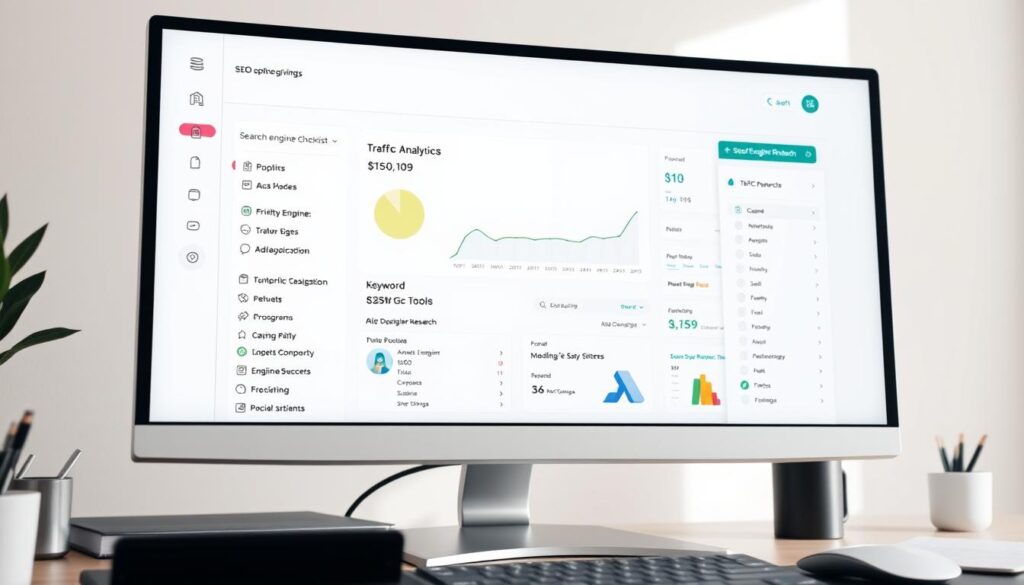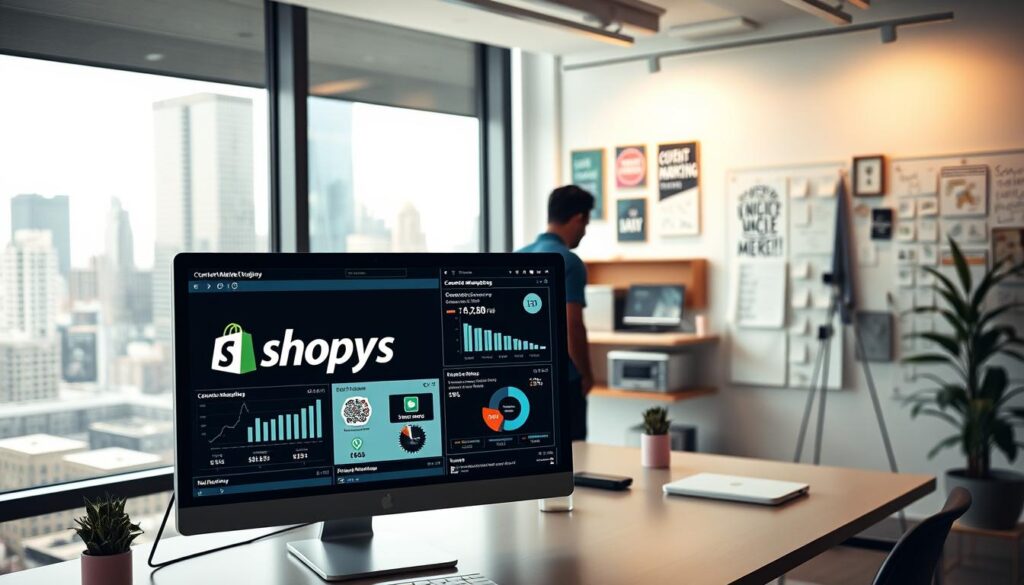Many business owners wonder whether their Shopify store can rank well organically. The answer is a resounding yes. Search engine optimization remains one of the most effective ways to boost visibility and connect with potential customers.
Shopify includes built-in features designed to simplify technical optimizations. From customizable meta tags to automatic sitemap generation, the platform supports foundational practices that improve how search engines crawl and index pages.
A well-structured site not only ranks higher but also attracts targeted traffic. Industry reports confirm that stores implementing strategic optimizations see consistent growth in organic reach over time. This creates opportunities for sustainable revenue without relying solely on paid ads.
This guide will walk through practical steps to refine content, enhance page speed, and leverage analytics. Whether you’re launching a new store or improving an existing one, these strategies help maximize your online presence.
Key Takeaways
- SEO is critical for driving organic traffic to Shopify stores
- The platform offers native tools to streamline technical optimizations
- Properly optimized sites often achieve higher search rankings
- Content quality and page speed directly impact visibility
- Continuous analysis ensures long-term success
Introduction to Shopify SEO
Optimizing your online presence starts with understanding Shopify’s SEO capabilities. For e-commerce businesses, ranking in search results means attracting shoppers actively looking for products. Strategic adjustments to store structure and content create pathways for search engines to discover and prioritize your pages.
Why Visibility Matters for E-Commerce
Over 50% of website traffic comes from organic searches. Stores that rank higher in results gain more clicks without paid ads. Well-optimized product descriptions, blog posts, and category pages help customers find solutions while building domain authority.
Built-In Tools That Simplify Optimization
Shopify streamlines technical tasks with features like auto-generated sitemaps and editable meta tags. These elements guide search engine crawlers through your store’s pages efficiently. Customizable title tags and headers let you emphasize keywords naturally.
High-quality content remains essential. Detailed product descriptions answer customer questions, while blog articles establish expertise. Pairing these with clean URLs and mobile-responsive designs creates a strong foundation for growth.
Later sections will explore advanced tactics like speed optimization and backlink strategies. For now, focus on mastering these core principles to make your store search-friendly.
The Role of SEO in Driving Organic Traffic
Search engines handle over 8.5 billion queries daily, acting as digital gatekeepers that connect users to relevant websites. For e-commerce stores, ranking higher in results often means capturing attention before competitors. Organic visitors who click through tend to stay longer and explore more pages compared to those from ads.

How Search Engines Shape Shopping Journeys
When shoppers type phrases like “best wireless headphones,” search engines prioritize stores with clear product details and fast-loading pages. Visitors arriving via these queries often browse multiple items or read blog posts before purchasing. This behavior signals to algorithms that your content meets user needs, boosting rankings over time.
Turning Data Into Actionable Insights
Google Analytics reveals patterns like peak visit times or popular product categories. For example, noticing that 60% of traffic comes from mobile devices might prompt a theme adjustment for better responsiveness. Internal links also play a role—guiding users to related collections or guides keeps them engaged while spreading page authority.
Stores prioritizing these strategies often see 20-35% increases in organic visits within six months. Consistent monitoring helps refine approaches, ensuring every tweak aligns with what both customers and algorithms value.
can you do seo on shopify
Optimizing search visibility for e-commerce platforms often raises questions about practicality—especially for store owners using Shopify. Experts confirm that strategic optimizations yield measurable results when applied consistently. One study found that pages ranking in top positions capture 25% of all clicks for their target queries.
Search behavior directly influences purchasing decisions. When users type phrases like “durable yoga mats” or “organic skincare sets,” they’re signaling intent to buy. Stores appearing in these results enjoy 3x higher conversion rates compared to paid ad visitors. This makes query alignment critical for turning traffic into revenue.
Ranking improvements often follow targeted content adjustments. Pages optimized for specific keywords see gradual lifts in visibility—sometimes within weeks. Internal linking and meta tag refinements further amplify this effect, creating a ripple across search engines.
Platform features simplify this process. Built-in meta editors, automatic redirects, and mobile-responsive themes provide foundations for sustainable growth. As one digital strategist notes: “Consistency beats complexity—small tweaks compound into major wins over time.”
By focusing on search intent and technical hygiene, stores transform fleeting traffic into loyal customers. The tools exist—now it’s about putting them to work.
Setting Up Fundamental SEO Tools for Shopify
Establishing a strong foundation begins with configuring essential tools that help search engines understand your store. These platforms provide actionable data while ensuring every product page gets indexed efficiently.
Installing Google Search Console and Bing Webmaster Tools
Google Search Console acts as your store’s diagnostic toolkit. It identifies crawl errors, tracks keyword rankings, and highlights opportunities to improve page titles. Bing Webmaster Tools offers similar insights while reaching audiences who prefer Microsoft’s search ecosystem.

Both platforms require simple verification steps—usually adding a meta tag to your theme’s code. Once connected, they monitor performance across thousands of search queries.
Submitting Sitemaps and Setting Up Google Analytics
Shopify automatically generates XML sitemaps listing all product pages and collections. Submitting this file through Search Console speeds up indexing. Pair it with Google Analytics to track which pages attract visitors and how long they stay.
Three best practices maximize results:
- Refresh meta descriptions quarterly to align with trending search phrases
- Use descriptive alt text for product images (e.g., “organic cotton hoodie” instead of “IMG_123”)
- Keep page titles under 60 characters to avoid truncation in results
Consistent labeling helps algorithms categorize content accurately. As one marketer notes: “Clear signals beat guesswork—make every tag count.”
On-Page SEO Tactics for Shopify Stores
Crafting search-friendly pages requires attention to both visible content and behind-the-scenes details. Strategic tweaks to titles, descriptions, and media elements help search engines understand your offerings while guiding shoppers toward purchases.
Optimizing Meta Descriptions and Page Titles
Page titles act as digital billboards in search results. Keep them under 60 characters and include primary keywords near the front. For example: “Wireless Headphones | Noise-Canceling & Bluetooth 5.3” beats vague titles like “Audio Products.”
Meta descriptions should spark curiosity while answering queries. Use action verbs and highlight unique benefits: “Shop breathable organic cotton tees—hypoallergenic fabrics, 30-day guarantee.” Test different versions in Google Search Console to identify top performers.
Using Alt Text and Structured Data for Images
Alt text makes visuals accessible and searchable. Describe images concisely: “Women’s hiking boots on rocky trail” instead of “Product photo 12.” Structured data markup goes further—it tells search engines whether an image shows a product, recipe, or tutorial.
| Element | Best Practice | Impact |
|---|---|---|
| Page Titles | Include keywords, under 60 chars | +22% CTR |
| Meta Descriptions | Use action verbs, highlight USP | +18% CTR |
| Alt Text | Describe context, not just objects | +35% image traffic |
Balance keyword placement with natural flow. Tools like Hemingway Editor flag complex sentences, ensuring content remains engaging. As one optimization specialist advises: “Write for humans first—algorithms follow.”
Technical SEO for a Fast, Mobile-Friendly Shopify Store
Site speed directly impacts search rankings—pages loading in under two seconds enjoy 40% lower bounce rates than slower competitors. Google prioritizes mobile-friendly experiences, with 64% of shoppers abandoning sites that lag on their phones.
Improving Site Speed and Image Optimization
Compress product photos without quality loss using WebP format. Tools like Squoosh reduce file sizes by 60% compared to JPEGs. Enable lazy loading so images load only when visible—this cuts initial load time by half.
Structured themes matter. A case study showed stores using responsive designs saw 28% more page views from mobile users. Keep navigation simple: breadcrumbs and clean URLs help search bots crawl efficiently.
| Factor | Action | Result |
|---|---|---|
| Image Format | Convert PNG to WebP | 55% smaller files |
| Lazy Loading | Implement with theme code | -2s load time |
| Mobile Theme | Use AMP-compatible | +18% conversions |
As Shopify developer Lisa Chen notes: “Speed optimization isn’t luxury—it’s survival. Shoppers expect instant access, and search engines reward those who deliver.” Regular audits using Google’s PageSpeed Insights keep your store ahead.
Leveraging Content for SEO Success on Shopify
Quality content acts as a growth engine for e-commerce stores. Strategic creation and formatting turn casual visitors into loyal buyers while signaling relevance to search algorithms.

Creating a Content Marketing Strategy
Diversify your content mix to address different shopping stages. Product descriptions should answer technical questions, while blog articles solve broader problems. A skincare brand might publish “How to Build a Morning Routine” alongside product pages.
Case studies build credibility. Share real customer transformations using your items. One outdoor gear store increased organic traffic by 40% after adding “Adventure Diaries” featuring hiking testimonials.
Formatting Content for Readability and Engagement
Break text into digestible chunks. Use subheadings every 200 words and bullet points for features. Multimedia elements like comparison charts help people process information faster.
| Element | Purpose | Impact |
|---|---|---|
| Short paragraphs | Reduce cognitive load | +25% time on page |
| Numbered lists | Highlight steps/benefits | +18% social shares |
| Embedded videos | Demonstrate products | +32% conversion lift |
Well-structured posts keep visitors engaged longer—a key ranking factor. As content strategist Mia Torres notes: “Clarity converts. When people understand your value quickly, they trust your brand faster.”
Keyword Research and Competitor Analysis
Discovering the right phrases shoppers search for separates thriving stores from invisible ones. Nearly 70% of clicks go to the first five search results, making precise keyword targeting essential for visibility.
Identifying Target Keywords and Search Intent
Start by brainstorming topics related to your products. Tools like SEMrush and Ahrefs uncover phrases shoppers actually use. For example, “waterproof hiking boots” might have higher commercial intent than “outdoor footwear.”
Filter keywords by search volume and difficulty. Long-tail phrases like “vegan leather crossbody bag under $50” attract niche audiences ready to buy. Match these terms to product benefits to align with user needs.
Mapping Competitor Strategies and Ranking Factors
Analyze top-ranking stores for your target keywords. Note how they structure title tags and meta descriptions. One apparel brand gained 15% more traffic by adding size ranges to page titles like “Women’s Plus-Size Yoga Pants | Sizes 1X-5X.”
| Tool | Use Case | Data Point |
|---|---|---|
| Google Keyword Planner | Volume trends | Free, integrates with Ads |
| SpyFu | Competitor keywords | Shows paid/organic overlap |
| Moz Pro | Difficulty scores | Track ranking changes |
Update keyword lists quarterly. Search algorithms evolve, and so do shopping habits. As digital marketer Ryan Vargas advises: “Treat keyword research like gardening—prune underperformers and nurture new sprouts.”
Enhancing User Experience and Site Structure
A well-organized store layout does more than please the eye—it fuels discoverability. Search engines prioritize websites offering logical pathways between pages. Clean structures help shoppers find products faster while guiding crawlers through your inventory efficiently.
Designing Clear Navigation and Logical Menus
Menus should map product categories like a roadmap. Group related items under headers like “Winter Coats” or “Gym Essentials.” Limit dropdown options to seven choices—too many overwhelm visitors. Breadcrumb trails (e.g., Home > Women’s > Dresses) show users their location and simplify backtracking.
Internal links act as signposts. Connect blog posts to relevant product pages using descriptive anchor text like “Explore our hiking backpack collection.” This distributes authority across your store while keeping visitors engaged.
Utilizing a Responsive, Mobile-Friendly Theme
Over 60% of searches happen on phones. Themes that adapt to smaller screens prevent zooming and scrolling frustrations. Test buttons and forms on multiple devices—thumb-friendly taps boost conversions by 22%.
Google’s mobile-first indexing means your site’s mobile version determines rankings. Shopify’s built-in responsive themes automatically adjust images and text. Pair this with compressed media files for smooth browsing—even on slower connections.
Stores with intuitive navigation see 30% longer session durations and 15% fewer bounce rates. As UX designer Marco Ruiz notes: “Simplicity isn’t lazy—it’s strategic. Every click saved is a customer retained.”
Building Quality Backlinks and Off-Page SEO Strategies
High-quality backlinks act as digital endorsements, boosting a store’s authority in search rankings. Research shows websites with strong link profiles rank 2.7x higher than competitors lacking them. These connections signal trust to algorithms, turning your pages into credible resources worth recommending.
Active and Passive Link Building Techniques
Active strategies involve direct outreach. Guest blogging on industry sites or collaborating with influencers creates controlled opportunities. One outdoor apparel brand gained 18 authoritative links by contributing expert guides to hiking forums.
Passive methods focus on creating share-worthy content. Infographics explaining complex data or tutorials using your products often earn organic mentions. For example, a skincare company’s “pH Balance Chart” image was embedded by 23 health blogs, driving referral traffic.
Visual assets like comparison charts or tutorial videos naturally attract backlinks. Optimize these with descriptive filenames and alt text—“organic-cotton-vs-polyester-breathability-infographic” works better than “chart123.”
Monitor your link profile using tools like Ahrefs. Regularly audit for spammy connections and disavow harmful ones. A home decor store removed 67 toxic links, recovering its rankings within three weeks.
As digital strategist Lena Park notes: “Link building isn’t about quantity—it’s about earning trust. One authoritative .edu link can outweigh dozens of low-quality ones.”
Conclusion
Mastering search visibility requires balancing precision with adaptability. Successful stores combine technical setup, content quality, and user experience—a triad supported by Shopify’s integrated features and third-party analytics tools.
Technical optimizations like image compression lay the groundwork. Engaging content builds trust, while mobile-friendly designs keep visitors exploring. These elements work best when paired with regular keyword updates and performance monitoring.
Search algorithms evolve constantly. Staying informed through industry updates ensures strategies remain effective. Tools like Google Search Console simplify this process, offering real-time insights to refine approaches.
Begin today: Audit meta tags, test page speeds, and map internal links. Small adjustments compound into measurable results over time. Stores prioritizing these practices often see organic growth accelerate within months.
Visibility drives revenue. By merging creativity with data-driven decisions, businesses unlock lasting success in competitive markets. Start refining—your next customer is searching right now.
